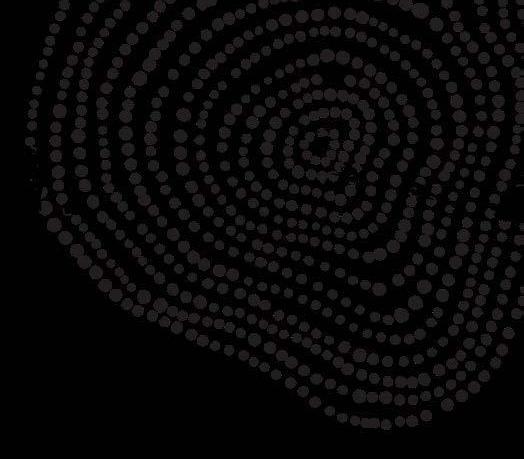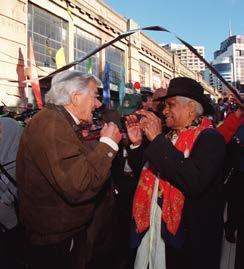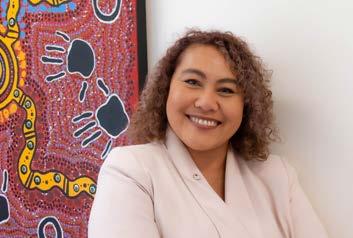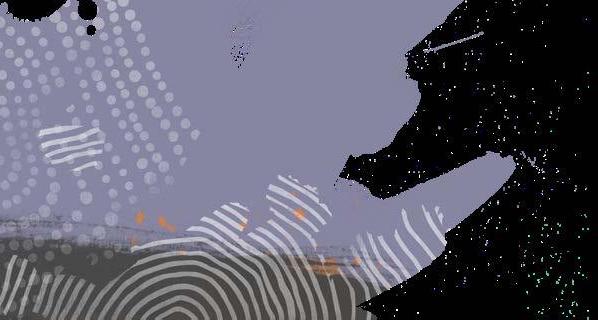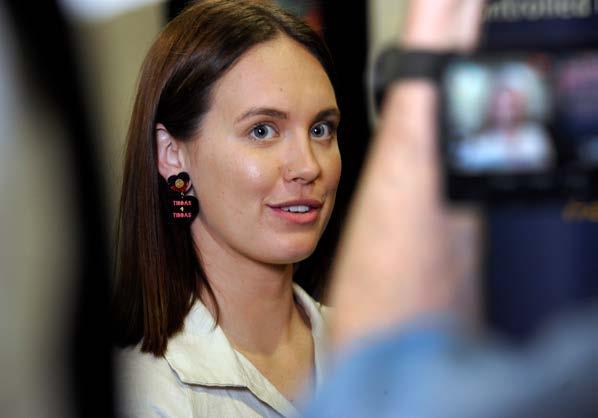
9 minute read
In my blood it runs
Dujuan Hoosan in school (Photo by Maya Newell)
‘I was born a little Aboriginal kid. That means I had a memory, a memory about Aboriginals. I just felt something... History, in my blood it runs.’ – Dujuan
The recently released documentary film, In My Blood It Runs follows the story of 10-year-old Arrernte/Garrwa boy, Dujuan Hoosan, as he shares his wisdom of history and the complex world around him. Dujuan grapples with the longstanding and continuing inequities of the Australian education system, all the while finding the space to dream for his future self.
Reconciliation Australia is a proud education partner for the film. Unfortunately Covid-19 restrictions mean the film’s public cinema screenings have been suspended, however, it will be free for teachers to screen in online classrooms till 3 June during National Reconciliation Week.
In My Blood It Runs teaches us about the current state of reconciliation in education.
Indeed, Reconciliation Australia’s five dimensions of reconciliation – race relations; historical acceptance; equality and equity; institutional integrity; and unity – are all evident in this eloquent film.
In keeping with historical acceptance, the film shows that the truths of our nation’s history since colonisation have either been missing from school curricula, or have been taught in ways that marginalise Aboriginal and Torres Strait Islander voices and perspectives. Dujuan’s story demonstrates the importance of teachers who – alongside members of the wider Australian community – challenge long-held assumptions and commit to an ongoing practice of ‘unlearning’ and ‘relearning’ the historical truths of our nation’s shared story.
In My Blood It Runs highlights the intricacies of the ‘teacher-as-learner’ and ‘learner-as-teacher’ interplay and, in alignment with the equality and equity dimension, illustrates the importance of upholding the unique rights of children, and of Aboriginal and Torres Strait Islander peoples – young and old.
Since the film’s making, Dujuan has addressed the Human Rights Council at the United Nations in Geneva, one of the youngest to do so.
‘Many people don’t see my strength, my culture and me learning from my Elders and my Land. This is who I am and they don’t see this at school,’ he told the Council.
Dujuan’s story shows how actively listening to the voices of children, building relationships with community and building connections with Country/place is crucial to informing and improving twoway learning opportunities.
Collective learning should coincide with collective action. Actively recognising that reconciliation is everybody’s business, and for everybody’s benefit, is critical to driving institutional integrity in the education context.
In My Blood It Runs highlights the sometimes problematic interrelationships across the education, welfare and justice systems.
It advocates for systems-level change in Australian education, recognising that challenges faced by teachers in building culturally competent classrooms are often reflective of broader institutional issues across the education sector, and perpetuated across generations.
‘What I want is a normal life of just being me. And what I mean by ‘me’ is I want to be an Aborigine.’ – Dujuan
The film arose organically from the decade-long relationships that Director, Maya Newell, has shared with Arrernte Elders, families, and community organisations such as Children’s Ground and Akeyulerre Healing Centre.
The tender way it represents the complex struggles of Dujuan and his families’ lives is thanks to the close collaboration between the core partners – the filmmaking team, the Arrernte and Garrwa families in the film and the film’s board of advisors.
This ongoing collaborative process shows how positive race relations can practically support a shared sense of unity, while still ensuring that each partner understands their role and retains control over how their stories are portrayed.

RAPS – NURTURE AND LOVE FOR RECONCILIATION


Fred Chaney (lef)t with Conference attendees Alan Carter and Pat Walker.
Founding Co-Chair of Reconciliation Australia, Fred Chaney, has had a life defined by his dedication to Aboriginal rights. As a leading Western Australian proponent for the 1967 Referendum, in his key involvement in establishing the Aboriginal Legal Service of Western Australia, and then as Federal Minister for Aboriginal Affairs between 1978-80, Fred has made significant contributions to the cause of reconciliation.
The following is an edited version of Fred Chaney’s key note address to the 2019 National RAP Conference.
My interest in reconciliation long predates the use of that term to describe our attempts to mend the relationship between First Nations people and the rest of us, and with the disastrous social, economic and cultural impact of settlement on Indigenous Australians.
There are many truths yet to be told but most Australians now know the bare bones of the Indigenous history of dispossession, dispersal and disadvantage. So much of the present is the product of the past. Most of the unfinished business of reconciliation flows from history. The need for Reconciliation Action Plans is a product of that history.
As a child in the forties and fifties I was educated about the courage and endurance of the explorers and the settlers who followed. Born in the second World War, I knew the stories of the brave diggers. Losing a grandfather in WW1 and having a father decorated for bravery in WW2 I was conscious of the bravery of Australians at war, of our Empire connections and of my status then as a British subject. These parts of our past still matter to me. My commitment to Australia, its democracy and its ‘fair go’ flow from what has gone before, and from what I knew about my grandparents and saw in my parents.
Mentioning these things emphasise that the past matters, and that what we know about it colours what we believe and what we do. Understanding the need for RAPs now requires an understanding of where we have come from and how we got here and where we need to be.
I became conscious that my version of Australia and its history was incomplete in 1956 when, in year 11, I first met an Aboriginal person. She was a domestic servant, well treated but in a subtle way, beyond my comprehension, treated differently.
I later described that first meeting like this: “My teenage memories of the position of the Aboriginal people in my state of Western Australia in the 1950s and ‘60s remain sharp. It is of them being excluded from the normal benefits of being Australian; denied the vote and other civil liberties afforded generally to others; confined to reserves living in humpies, tin sheds and car bodies; casually prostituted and abused; denied education and employment; and treated with overt contempt beyond the racism still seen today.”

The recent films about the treatment of the great AFL footballer and Australian of the Year, Adam Goodes, are painful reminders of the persistence of racism, much as we seem to hate having it drawn to our attention.
For some strange reason our sense of egalitarianism and mateship did not apply to Indigenous people.
I particularly mention the idea of equality of citizenship, because that important idea is part of why constitutional recognition is contentious to some of our fellow Australians – yet it was also the principle that drove many of the positive changes in the legal position of Aboriginal people. Most of us are aware of their continuing disadvantage, and Australia today is a much better place for Indigenous Australians than the Australia of my youth. Voting rights were legislated in 1962, followed shortly by the overwhelming vote for the 1967 referendum which was really about equal citizenship.
Then followed Commonwealth acceptance of the need to support Indigenous culture and connection to land and the need for special services in the pre-Whitlam 1972 budget; the Woodward Enquiries and all-Party support for NT land rights in 1976, and passing of land rights legislation in South Australia, NSW, Queensland and Victoria during the 1980s.
All of these changes predate the formal reconciliation movement which began as one of the responses to the wake-up call of the Deaths in Custody Royal Commission.
In 1991 the decade of reconciliation commenced under the leadership of the Council for Aboriginal Reconciliation. In 1992 the High Court decision in Mabo formalised recognition of Indigenous collective rights. In 1993 the Native Title Act passed and the arduous process of getting recognition commenced. It is worth noting that at first the mining industry violently campaigned against native title. However, the Mabo decision’s recognition of native title holders as stakeholders rather than supplicants worked its magic. In 1995 Leon Davis, CEO of Rio Tinto, made a landmark speech promising to work with native title. That was the beginning of a revolution that started with the great mining companies and spread through Australia’s biggest commercial enterprises. Corporate Australia became a key recruiting ground for, and an instrument of, change.
But while many Indigenous people applauded the sentiments, they asked the critical question, “But when will things be different?”. Even in the midst of celebrating the joyous days of the 2000 bridge walks I heard that question asked, and it remains a question that underlies the idea of RAPs. How do you go from good words into good actions?
Another critical point is that reconciliation can’t come from top down government interventions only. Governments are vital to reconciliation in that only they can ensure that Indigenous Australians have access to civil and political rights and liberties. They control and resource schools, hospitals, public amenities, courts, prisons, and welfare for the old, the sick, the unemployed and the disabled.
But governments do these things impersonally, blind to individual circumstances. Health, education and employment require more than an allocation of resources. They require nurture and I would say love. Governments don’t do nurture and love. They at best treat citizens equally. It is the non-government and community sector that can bring a care-driven approach.
Through RAPs, some companies have achieved remarkable employment growth in relatively short order. While some of this has happened without the support of a RAP, usually driven by committed CEOs, RAPs do keep efforts on track and improving. Corporations are used to setting end targets and then marshalling the whole range of resources needed to meet their targets despite complexity and internal silos.
Public servants are not authorised to respond to subjectivity. Their accountabilities to parliaments, to auditors and to anti-corruption bodies are necessarily rules-based, so we need whole of community responses to achieve reconciliation.
RAPs have exploded and RAP organisations are playing an increasing public role in supporting Indigenous aspirations including demands of the Uluru Statement from the Heart: a constitutionally enshrined Voice to Parliament, a Makarrata Commission and truth telling.
RAPs are critical in educating our community about the aspirations of First Nations and they are critical in practical responses to these aspirations.
RAPs will continue to cement in the commitments made by so many elements of the Australian community, to grow those commitments, and encourage continuous improvement via the ladder of RAP categories from the beginnings of a Reflect RAP, through the Innovate and Stretch RAPs, and the final leadership of an Elevate RAP.
When I was young it seemed almost every hand was turned against Indigenous wellbeing; enemies were everywhere. Now RAPs tell us the allies are everywhere. Part of our role as nonIndigenous people is to get the message out to our Indigenous fellow Australians that they have a lot of allies. We have ears as well as voices and that they can count on us to walk with them.

